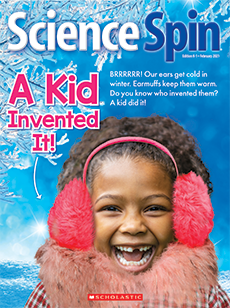October 2023
SO SCARY?
Academic Standards
Reading Objective:
Students will be introduced to a lemur from Madagascar called the aye-aye and recognize that while its behavior may seem scary, it is just seeking the food it needs to survive.
Next Generation Science Standards:
K-LS1-1: What animals need to survive
1-LS1: How animals use their external parts to survive and grow
Vocabulary:
wild, grub, poke, hook
Check comprehension and inspire discussion.
1. What are the aye-aye’s fingers like?
(Long and skinny)
2. Why does the aye-aye tap its finger on a tree?
(to find grubs)
3. How does the aye-aye make a hole in the tree?
(with its teeth)
4. Why does the aye-aye hunt for grubs?
(to eat them)
Go online to print or project the Reading Checkpoint.
- Aye-ayes make strange noises. They scream when they’re mad. They yell “hai-hai” when runningaway. This may be the reason they got the name “aye-aye.”
- People used to think aye-ayes were dangerous animals that gave people bad luck. But animal doctors who have cared for aye-ayes say they are sweet and gentle!
Materials: Assorted “bony fingers” (see above), “grubs” (see above), cardboard containers or tubes to act as “tree branches,” pencils, copies of the skill sheet
Overview: Kids test different “bony fingers” (pencils, pens, Popsicle sticks, straws, pipe cleaners, etc.) to extract “grubs” (bits of clay or playdough or soft candy or raisins) from inside a “branch” (TP roll, tissue or cereal box with a hole in the side). Which works best?
Directions:
- Before the lesson, set up stations with a cardboard container filled with “grubs” along with “bony finger” tools. Or plan this as a demonstration where kids help.
- Start the lesson by reminding kids that aye-ayes poke a bony finger into a tree branch to grab grubs.
- Show them your version of a tree branch, and the options for “bony fingers.” Which “finger” do they think will make it easiest to grab a grub? Which will make it hardest? Let them share predictions with a partner.
- Test the bony fingers. Which was easiest to grab a grub with? Which was hardest? Students can record results on the skill sheets.
- If there’s time, have kids report their results to the class.
